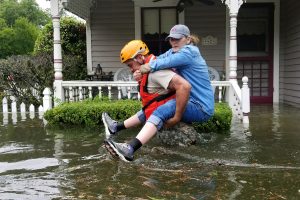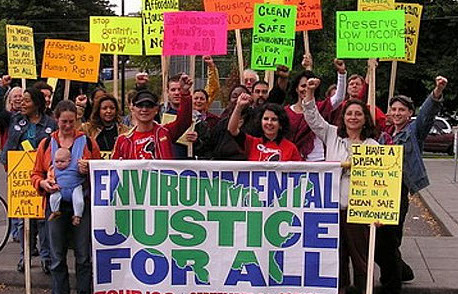By Dena Adler

It has been widely reported that Hurricanes Harvey and Irma inundated industrial plants, wastewater treatment plants, and Superfund sites, causing a stew of toxic chemicals and sewage to leak into floodwaters and releasing almost 1 million pounds of seven deadly pollutants into the air. The Union of Concerned Scientists, for instance, has identified more than 650 energy and industrial facilities potentially exposed to Hurricane Harvey’s floodwaters. In the days following Hurricane Harvey, The New York Times reported at least 14 toxic waste sites were flooded or damaged and roughly 100 spills of hazardous substances were phoned in to the National Response Center from Southeast Texas. Liquid mercury was found washing ashore residential riverfront property east of Houston and the AP tracked 3 potentially contaminated leaks from one of Texas’ dirtiest Superfund toxic waste sites. Though Florida may not have the same chemical epicenter as Houston, its nuclear reactors, mines, and low-lying Superfund sites could wreak havoc if flooded, and Irma resulted in more than 28 million gallons of sewage gushing into streets, homes, and waterways in 22 counties.
In addition to posing a public health nightmare, these contaminated floodwaters and toxic air emissions could indicate potential environmental statutory violations under the Clean Water Act (CWA), the Oil Pollution Act of 1990 (OPA), the Resource Conservation & Recovery Act (RCRA), the Clean Air Act (CAA), the Emergency Planning and Community Right-to-Know Act (EPCRA), and the Comprehensive Emergency Response, Compensation, and Liability Act (CERCLA). While a comprehensive review of liability is beyond the scope of this blog, below, I discuss several of the legal requirements possibly violated which could usher in a wave of climate change-related lawsuits. Notably, this litigation dodges the sticky issue of climate change attribution – facilities and municipalities are liable for failing to undertake adequate preparatory, safety, and control measures without needing to prove a link between global climate change, the particular storm, and actual harms suffered.
First, under Section 402(p) of the Clean Water Act, industrial facilities, construction sites, and municipal separate storm sewer systems are on the hook for contaminated runoff and must obtain National Pollutant Discharge Elimination System (“NPDES”) permits for their storm water discharges. As part of their permits, most of these facilities must prepare a Stormwater Pollution Prevention Plan and meet numerous monitoring, reporting, and technology standards. Publicly-owned treatment works are also required to meet numerous monitoring, reporting, and control standards under 40 C.F.R. § 122.21(j).
Second, regulations under the CWA, OPA, CERCLA, RCRA, and EPCRA, spell out additional safety measures for facilities with oil and hazardous substances. Specifically, Section 311 of the CWA as expanded by OPA (40 C.F.R. § 112, Subpart A), requires all facilities with oil or hazardous substances to design and implement Spill Prevention, Control, and Countermeasures Plans to prevent polluting water ways. RCRA regulations similarly require facilities which produce, handle, or dispose of hazardous waste to develop emergency contingency plans that “minimize hazards to human health or the environment from fires explosions, or any unplanned or sudden or non-sudden release of hazardous waste or hazardous constituents to air, soil, or surface water.” (40 C.F.R. § 265.52). To obtain a permit under RCRA, applicants must describe their practices and equipment to prevent flooding, stop runoff from hazardous waste handling areas, and mitigate equipment failure and power outages. Facilities located in a 100-yr flood plain must specifically explain how the facility design will withstand flooding and avoid accidental releases. The permits themselves often contain extremely detailed requirements, either in their text or by reference to the contents of the permit applications.
Third, toxic fumes such as those released by the explosion at the Arkema plant in Crosby, Texas could indicate violations of the Clean Air Act Section 112(r) amendments which require facilities that use extremely hazardous substances to develop a Risk Management Plan. This plan must explain the facilities’ preventative measures to avoid a chemical accident, effects of a potential accident, and emergency response procedures. The Arkema plant is subject to the 112(r) requirements and just earlier this year was penalized for health and safety violations by the Occupational Safety and Health Administration.
Given that the Texas Gulf Coast is a hotbed of oil refineries and petrochemical plants, it is reasonable to expect that many facilities would be subject to the above planning and control requirements for hazardous air and water emissions. Again, the accidental releases of hazardous materials into the environment from recent extreme events might indicate noncompliance and consequent liability.
Then again, it might not. In most cases, compliance with permit planning requirements under these statutes forms a litigation shield and largely prevents facilities from being held liable for leaking pollutants. And therein lies the problem. As climate change increases the frequency and intensity of storms, static technology and planning standards, combined with permit shields for leaking facilities, could quite literally water down environmental protections. Facilities must strengthen their storm preparation to avoid putting citizens and the environment at risk.
The CWA, in particular, is intended to have this adaptability. If baseline technology requirements prove insufficient to protect state-adopted water quality standards, the states are responsible for tightening the allowances in permits. The devastation suffered the current hurricane season demonstrates it is past time for the EPA and the states to update the permitting requirements for facilities vulnerable to climate change impacts such as sea level rise, storm surge, and more frequent and intense storms.
Recent litigation brought by the Conservation Law Foundation (CLF) may help spur updates in some of these permitting programs and invigorate companies’ and municipalities’ approaches to compliance. On August 28th, CLF filed a citizen suit against Shell Oil, alleging that their petroleum storage facilities in Providence, RI violated the Clean Water Act because they did not prepare for the increased coastal flooding risk from climate change. CLF argues that in light of the company’s knowledge about climate change risks, Shell failed to conform its Stormwater Pollution Prevention Plan with good engineering practices, to identify all sources of pollution, to describe and implement practices to reduce pollutants, to address the adequacy of containment measures for leaks and spills in storage and truck loading areas, to amend or update its Stormwater Pollution Prevention Plan, and to properly operate and maintain facilities and systems of treatment.
The lawsuit is similar to one brought by CLF last year against ExxonMobil’s Everett Terminal in Massachusetts. In that lawsuit, CLF alleged violations of both the CWA and RCRA. ExxonMobil filed a motion to dismiss on the grounds that CLF lacked standing because climate change impacts were speculative and too far in the future and further alleged CLF’s RCRA claims did not meet the “imminent and substantial endangerment,” requirement for a suit under RCRA § 7002(a)(1)(B). Similarly, it claimed that climate change impacts need not be considered for the CWA’s NPDES permits, Stormwater Pollution Prevention Plans, and Spill Prevention, Control and Countermeasure Plans.
On September 13th, the U.S. District Court for the District of Massachusetts found that CLF has standing to sue for present and imminent “injuries to its members’ aesthetic and recreational interests in the Mystic River.” However, the court also separated out a component of the lawsuit finding that CLF lacks standing “for injuries that allegedly will result from rises in sea level, or increases in the severity and frequency of storms and flooding, that will occur in the far future, such as in 2050 or 2100.” The court reasoned that “the Environmental Protection Agency may require changes to the [p]ermit that will prevent the harms from occurring.” Still, looking at present and imminent storm-related risks, the court found facts sufficient to support a claim that Exxon was currently discharging pollutants in excess of its permit and to recognize the “substantial risk” that severe weather events could cause the terminal to violate its permit in the near future. Thus, the litigation will proceed.
The district court’s decision on standing underscores the lesson that Hurricanes Harvey and Irma graphically depicted – climate change damages are happening now and the law must keep pace by requiring industry and municipalities to update their technology and best practices. As extreme storm events become more frequent, the defense that climate change impacts are remote and speculative is weakening. The court’s rejection of a right to claim standing based on injuries stemming from sea level rise in the second half of the century may be reasonable, but it leaves it to EPA, state agencies, municipalities with waste water treatment plants, and owners of industrial facilities to better integrate climate change into permitting requirements and prevention plans.
In addition to environmental statutory violations, flooding-related harms also raise more traditional claims under tort law. Already, tort litigation has been filed by first responders injured when the Arkema plant exploded and spewed poisonous fumes. Plaintiffs allege that the company did not adequately prepare for a foreseeable storm event and failed to sufficiently warn the public about the risks of explosion. Arguably, these are climate cases by another name, especially as extreme events such as Harvey grow increasingly foreseeable, and the science of attributing extreme weather events to climate change continues to develop.
For industry concerned about mounting liability and municipalities eager to protect their citizens, success stories up and down the coast illustrate how to get storm preparation right. FEMA funds have supported more robust infrastructure like the Emerald Coast Utilities Authority’s central reclamation facility located in Escambia County, Florida. Municipalities also have a number of legal resources to advance adaptation planning and capacity. After Sandy, New York City issued new reporting requirements for facilities storing hazardous chemicals and located within special flood hazard areas or hurricane evacuation zones. For coastal facilities vulnerable to sea level rise and storm surge an ounce of prevention will be worth far more than a quart of cure.




